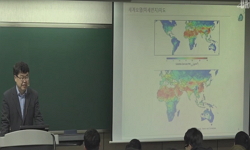Tuberculation and slime accumulated in water mains play an important role in modifying water quality of drinking water. Therefore, in this study, it was investigated that what materials were accumulated, and what components were included in the tuberc...
http://chineseinput.net/에서 pinyin(병음)방식으로 중국어를 변환할 수 있습니다.
변환된 중국어를 복사하여 사용하시면 됩니다.
- 中文 을 입력하시려면 zhongwen을 입력하시고 space를누르시면됩니다.
- 北京 을 입력하시려면 beijing을 입력하시고 space를 누르시면 됩니다.
https://www.riss.kr/link?id=A103323542
- 저자
- 발행기관
- 학술지명
- 권호사항
-
발행연도
2014
-
작성언어
Korean
- 주제어
-
등재정보
KCI등재
-
자료형태
학술저널
- 발행기관 URL
-
수록면
589-600(12쪽)
-
KCI 피인용횟수
0
- DOI식별코드
- 제공처
-
0
상세조회 -
0
다운로드
부가정보
다국어 초록 (Multilingual Abstract)
Tuberculation and slime accumulated in water mains play an important role in modifying water quality of drinking water. Therefore, in this study, it was investigated that what materials were accumulated, and what components were included in the tuberculation and slime of water mains. The Various tuberculation and slime sample were collected from the 12 water mains to analyze their physical and chemical properties and crystal structure. As a analysis method, VSS(Volatile suspended solid), SEM(scanning electron microscope), EDS(Energy Dispersive X-ray spectroscope), ICP(Inductively Coupled Plasma Mass Spectrometer) and XRD(X-Ray Diffractomete) were used. The results of analysis on the samples, the representative materials were verified such as iron corrosion products, the fine sand particles generated during backwash, fine particles of activated carbon, aluminum used in coagulation process, and manganese included in raw water.
참고문헌 (Reference)
1 Clark, R.M, "Water quality changes in a simulated distribution system" 43 : 263-, 1994
2 Kolle, W, "Untersuchungen an Rohrnetz-Inkrustierungen unter mineralogischen Gesichtspunkten" 55 : 159-178, 1980
3 Walski , T.M, "Understanding Solids Transport in Water Distribution Systems" Water Quality Modelling In Distribution Systems 305-309, 1991
4 Hallam, N.B, "The potential for biofilm growth in water distribution systems" 35 (35): 4063-, 2001
5 Allen, M. J, "The occurance of microorganisms in water main encrustations" 72 : 614-625, 1980
6 Gerke, T, "Physiochemical characterization of five iron tuberckes from a single drinking water distribution system : Possible new insights on their formation and growth" 50 : 2030-2039, 2008
7 Sarin, P, "Physicochemical characteristics of corrosion scales in old iron pipes" 35 (35): 2961-2969, 2001
8 Nagy L . A, "Occurrence and significance of bacteria, fungi, and yeasts associated with distribution pipe surfaces. Proceedings of the American Water Works Association" American Water Works Association 213-, 1985
9 Evans, U.R, "Metallic corrosion, Passivity and Protection" Edward Arnold Ltd 1937
10 Emde, K.M.E, "Initial investigation of microbially influenced corrosion (MIC) in a low temperature water distribution system" 26 : 169-175, 1992
1 Clark, R.M, "Water quality changes in a simulated distribution system" 43 : 263-, 1994
2 Kolle, W, "Untersuchungen an Rohrnetz-Inkrustierungen unter mineralogischen Gesichtspunkten" 55 : 159-178, 1980
3 Walski , T.M, "Understanding Solids Transport in Water Distribution Systems" Water Quality Modelling In Distribution Systems 305-309, 1991
4 Hallam, N.B, "The potential for biofilm growth in water distribution systems" 35 (35): 4063-, 2001
5 Allen, M. J, "The occurance of microorganisms in water main encrustations" 72 : 614-625, 1980
6 Gerke, T, "Physiochemical characterization of five iron tuberckes from a single drinking water distribution system : Possible new insights on their formation and growth" 50 : 2030-2039, 2008
7 Sarin, P, "Physicochemical characteristics of corrosion scales in old iron pipes" 35 (35): 2961-2969, 2001
8 Nagy L . A, "Occurrence and significance of bacteria, fungi, and yeasts associated with distribution pipe surfaces. Proceedings of the American Water Works Association" American Water Works Association 213-, 1985
9 Evans, U.R, "Metallic corrosion, Passivity and Protection" Edward Arnold Ltd 1937
10 Emde, K.M.E, "Initial investigation of microbially influenced corrosion (MIC) in a low temperature water distribution system" 26 : 169-175, 1992
11 LeChevallier, M. W, "Examination and characterization of distribution system biofilms" 53 : 2714-2724, 1987
12 Borch, T, "Evaluation of charcaterization techniques for iron pipe corrosion products and iron oxide thin films" 835-844, 2008
13 Friedman M, "Establishing Site-Specific Flushing Velocities" AWWARF 2004
14 Vreeburg, J.H.G, "Discolouration in drinking water systems: a particular approach" TU Delft 2007
15 Clement, J.A, "Analyses and interpretation of the physical, chemical and biological characteristics of distribution system pipe scales" 1998
16 Smith, S. E, "An Examination of Nature and Occurrence of Deposits in Distribution System and Their Effect on Water Quality" 1997
동일학술지(권/호) 다른 논문
-
- 대한상하수도학회
- 손동완
- 2014
- KCI등재
-
반응표면분석법을 이용한 터널폐수 응집-혼화 공정의 주요인자 영향 분석 및 최적화
- 대한상하수도학회
- 정세욱
- 2014
- KCI등재
-
- 대한상하수도학회
- 박규홍
- 2014
- KCI등재
-
- 대한상하수도학회
- 오현택
- 2014
- KCI등재
분석정보
인용정보 인용지수 설명보기
학술지 이력
| 연월일 | 이력구분 | 이력상세 | 등재구분 |
|---|---|---|---|
| 2026 | 평가예정 | 재인증평가 신청대상 (재인증) | |
| 2020-12-28 | 학술지명변경 | 외국어명 : Journal of the Korean Society of Water and Wastewater -> Journal of Korean Society of Water and Wastewater |  |
| 2020-01-01 | 평가 | 등재학술지 유지 (재인증) |  |
| 2017-01-01 | 평가 | 등재학술지 유지 (계속평가) |  |
| 2013-01-01 | 평가 | 등재학술지 유지 (등재유지) |  |
| 2010-01-01 | 평가 | 등재학술지 유지 (등재유지) |  |
| 2008-01-01 | 평가 | 등재학술지 유지 (등재유지) |  |
| 2006-01-01 | 평가 | 등재학술지 유지 (등재유지) |  |
| 2003-01-01 | 평가 | 등재학술지 선정 (등재후보2차) |  |
| 2002-01-01 | 평가 | 등재후보 1차 PASS (등재후보1차) |  |
| 2000-07-01 | 평가 | 등재후보학술지 선정 (신규평가) |  |
학술지 인용정보
| 기준연도 | WOS-KCI 통합IF(2년) | KCIF(2년) | KCIF(3년) |
|---|---|---|---|
| 2016 | 0.2 | 0.2 | 0.21 |
| KCIF(4년) | KCIF(5년) | 중심성지수(3년) | 즉시성지수 |
| 0.19 | 0.15 | 0.342 | 0.01 |




 ScienceON
ScienceON 코리아스칼라
코리아스칼라






